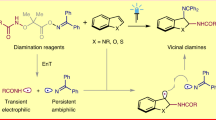Abstract
Environment-sensitive fluorophores have different quantum yields in different solvents. 6-Dimethylaminonaphthalimide (6-DMN), for example, has a low quantum yield in aqueous solutions, but is highly fluorescent in nonpolar solvents or when bound to hydrophobic sites in proteins or membranes. 6-DMN has been used to investigate protein-protein interactions, as well as the in-tissue distribution and internalization of δ-receptors. This protocol describes a highly efficient three-stage synthesis of 6-dimethylamino-2,3-naphthalenedicarboxylic anhydride (compound 1), which is a stable precursor that can be converted to 6-DMN. The three stages are (i) photo-bromination of 4-nitro-o-xylene (yield 82%), (ii) Diels-Alder reaction followed by base hydrolysis, resulting in 6-nitro-2,3-naphthalenedicarboxylic acid (yield 87%) and (iii) reductive amination followed by dehydration (yield 76.5%) to form compound 1. The synthesis can be performed on a gram scale (in 55 h over 3 d) with an overall yield of about 55%. It can easily be modified to prepare related compounds by, for example, performing different reactions using 6-nitro-2,3-naphthalenedicarboxylic acid.
This is a preview of subscription content, access via your institution
Access options
Subscribe to this journal
Receive 12 print issues and online access
$259.00 per year
only $21.58 per issue
Buy this article
- Purchase on Springer Link
- Instant access to full article PDF
Prices may be subject to local taxes which are calculated during checkout





Similar content being viewed by others
References
Vazquez, M.E., Blanco, J.B. & Imperiali, B. Photophysics and biological applications of the environment-sensitive fluorophore 6-N,N-dimethylamino-2,3-naphthalimide. J. Am. Chem. Soc. 127, 1300–1306 (2005).
Vazquez, M.E., Blanco, J.B. & Gianfranco, B. 6-N,N-Dimethylamino-2,3-naphthalimide: a new environment-sensitive fluorescent probe in δ-selective opioid peptides. J. Med. Chem. 49, 3653–3658 (2006).
Vazquez, M.E., Rothman, D.M. & Imperiali, B. A new environment-sensitive fluorescent amino acid for Fmoc-based solid phase peptide synthesis. Org. Biomol. Chem. 2, 1965–1966 (2004).
Venkatraman, P. et al. Fluorogenic probes for monitoring peptide binding to class II MHC proteins in living cells. Nat. Chem. Biol. 3, 222–228 (2007).
Alan, R.K., Ozcana, S. & Todadze, E. Synthesis and fluorescence of the new environment-sensitive fluorophore 6-chloro-2,3-naphthalimide derivative. Org. Biomol. Chem. 8, 1296–1300 (2010).
Nandhikonda, P. & Heagy, M.D. Dual fluorescent N-Aryl-2,3-naphthalimides: applications in ratiometric DNA detection and white organic light-emitting devices. Org. Lett. 12, 4796–4799 (2010).
Brown, F.K. & Brown, P.J. Matrix metalloproteinase inhibitors containing a (carboxyalkyl)-amino zinc ligand: modification of the P1 and P2 residues. J. Med. Chem. 37, 674–688 (1994).
Ralph, P.R. et al. Inhibitors of MMP-1: an examination of P1 gem-disubstitution in the N-carboxyalkylamine and glutaramide carboxylate series. Bioorg. Med. Chem. Lett. 6, 1725–1730 (1996).
Mathias, M. et al. Systematic development of high affinity bis(ammonio)alkane-type allosteric enhancers of muscarinic ligand binding. J. Med. Chem. 46, 1031–1040 (2003).
Saito, I. & Takayama, M. Photoactivatable DNA-cleaving amino acids: highly sequence-selective DNA photocleavage by novel L-lysine derivatives. J. Am. Chem. Soc. 117, 5590–5591 (1995).
Saito, I. et al. Photoinduced DNA cleavage via electron transfer: demonstration that guanine residues located 5′ to guanine are the most electron-donating sites. J. Am. Chem. Soc. 117, 6406–6407 (1995).
Saito, I., Takayama, M., Sugiyama, H. & Nakamura, T. DNA and RNA Cleavers and Chemotherapy of Cancer and Viral Diseases (ed. Meunier, B.) 163 (Kluwer Academic Publishers, 1996).
Bousquet, P.F. et al. Preclinical evaluation of LU 79553: a novel bis-naphthalimide with potent antitumor activity. Cancer Res. 55, 1176–1180 (1995).
Brana, M.F. et al. Bis-naphthalimides. 2. Synthesis and biological activity of 5,6-acenaphthalimidoalkyl-1,8-naphthalimidoalkyl amines. Eur. J. Med. Chem. 30, 235–239 (1995).
Hodgkiss, R.J. et al. Fluorescent markers for hypoxic cells: a study of nitroaromatic compounds, with fluorescent heterocyclic side chains, that undergo bioreductive binding. J. Med. Chem. 34, 2268–2274 (1991).
Hayes, B.A., Gupta, S., Chang, S.-C., Utecht, R.E. & Lewis, D.E. Photochemically activated antiviral halogenated 1,8-naphthalimides: synthesis of N, N′-BIS-{2-[(5-bromo-2-[1-14C]hexyl-1H-benz[DE]isoquinolin-1,3(2H)-dion-6-YL)amino]ethyl}hexanediamide. J. Labelled Compd. Radiopharm. 38, 607–612 (1996).
Barret Kalindjian, S. et al. Non-peptide cholecystokinin-B/gastrin receptor antagonists based on bicyclic, heteroaromatic skeletons. J. Med. Chem. 39, 1806–1815 (1996).
Sainlos, M. & Imperiali, B. Synthesis of anhydride precursors of the environment-sensitive fluorophores 4-DMAP and 6-DMN. Nat. Protoc. 2, 3219–3225 (2007).
Sainlos, M. & Imperiali, B. Tools for investigating peptide–protein interactions: peptide incorporation of environment-sensitive fluorophores through SPPS-based 'building block' approach. Nat. Protoc. 2, 3210–3218 (2007).
Baathulaa, K., Xu, Y. & Qian, X. Unusual large Stokes shift and solvatochromic fluorophore: synthesis, spectra, and solvent effect of 6-substituted 2,3-naphthalimide. J. Photochem. Photobiol. A: Chem. 216, 24–34 (2010).
Qian, X., BaBu, K. & Xu, Y. Method for the preparation of 2,3-naphthalic anhydride derivatives. Faming Zhuanli Shenqing (2010), 7pp, CN 101812042 A 20100825.
Kogure, T., Kawano, H., Abe, Y. & Miyawaki, A. Fluorescence imaging using a fluorescent protein with a large Stokes shift. Methods 45, 223–226 (2008).
Piatkevich, K.D., Malashkevich, V.N., Almo, S.C. & Verkhusha, V.V. Engineering ESPT pathways based on structural analysis of LSSmKate red fluorescent proteins with large Stokes shift. J. Am. Chem. Soc. 132, 10762–10770 (2010).
Acknowledgements
This work is supported by the National Basic Research Program of China (973 Program, 2010CB126100), the National High Technology Research and Development Program of China (863 Program 2011AA10A207), the Shanghai Leading Academic Discipline Project (B507) and the Fundamental Research Funds for the Central Universities. We thank Shanghai Municipal Government (SMGS) for funding and J. Srivani for valuable support.
Author information
Authors and Affiliations
Contributions
K.B. conducted the synthesis and determined the synthetic routes, and prepared the first draft and final version of the manuscript. X.Q. supervised all of the work and is the corresponding author. Y.X. prepared the final version of the manuscript and provided senior authorship.
Corresponding author
Ethics declarations
Competing interests
The authors declare no competing financial interests.
Rights and permissions
About this article
Cite this article
Baathulaa, K., Xu, Y. & Qian, X. Short and scalable synthesis of an anhydride precursor of the environment-sensitive fluorophore 6-dimethylaminonaphthalimide. Nat Protoc 6, 1990–1997 (2011). https://doi.org/10.1038/nprot.2011.415
Published:
Issue Date:
DOI: https://doi.org/10.1038/nprot.2011.415
Comments
By submitting a comment you agree to abide by our Terms and Community Guidelines. If you find something abusive or that does not comply with our terms or guidelines please flag it as inappropriate.



